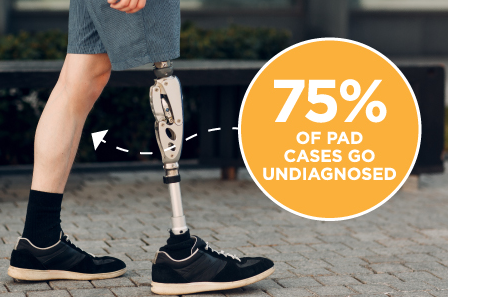
Many people associate peripheral arterial disease (PAD) with diabetes. But you don’t need to have diabetes to develop PAD, and the symptoms can be so mild that many people don’t even notice them. All too often, the disease is far along by the time it does get diagnosed, and amputation (especially leg amputation below the knee) is often the result.
How does this affect you if you’re already an amputee? First of all, amputation isn’t the only potential consequence of PAD. It also routinely leads to heart attacks and strokes. Second, all amputees tend to fall into high-risk categories for PAD, regardless of whether the limb loss resulted from arterial disease. Statistically speaking, you’re more likely to develop PAD if you:
* Are physically inactive
* Are overweight
* Are older than 50
* Have high cholesterol
* Have high blood pressure
* Smoke tobacco
The first five items on that list of risk factors apply to a large number of amputees. You’ll be 50 years old some day if you’re not already, so that one’s kind of a given. We’re all stuck with it. And it’s not inconsequential: 1 in 20 American over 50 years old has PAD.
Age aside, you can manage the other risk factors via lifestyle choices that reduce your susceptibility to PAD. Here are some suggestions for decreasing your risk of heart attack, stroke, or another adverse outcomes related to PAD.
Move: Regular physical activity is incredibly important. Studies have shown that exercise not only decreases the symptoms of PAD but can also diminish progression of the disease. You don’t have to join a gym or start training for a marathon. Just take a walk every day around your neighborhood, starting with short distances and increasing slowly until you can walk for 30 to 45 minutes at least 5 days per week.
Eat healthy: Skip the fast-food drive through and reach for an apple, banana, or some carrots instead. Replacing sugary, high-fat, sodium-laden foods with fresh fruits, vegetables, and grains is the most effective way to keep your arteries healthy.
Read the label: The Mayo Clinic states that over-the-counter cold medicines containing pseudoephedrine can constrict your blood vessels and make PAD symptoms worse. Not all cold medicines contain pseudoephedrine, so take a few seconds to scan the label before tossing it in your shopping cart.
Kick the habit: Smokers have up to four times greater risk of PAD than the general population. Quitting will significantly reduce your risk of PAD-related complications.
Visit your doctor: It’s important to get an official diagnosis for PAD. The initial tests are easy and unobtrusive, so pick up the phone and make that appointment.